Types and names of the best varieties of garlic with a description
Garlic varieties suitable for the climate and soil composition, will delight you with a large harvest. Possessing a large list of useful properties and an unusual taste, this spicy vegetable is planted by everyone who has a land plot. To figure out which variety of garlic is the largest, it is recommended that you first familiarize yourself with the description of each of them.
There are two types of garlic: spring and winter. Spring garlic begin to plant at the end of April, and start planting winter garlic in the spring, at the end of September. Winter types of garlic shoot an arrow on which a box of seeds is formed. The onion consists of several large-sized cloves located around the central shaft. In fruits of spring garlic, the stem is absent, and small numerous cloves are arranged in several rows in a spiral. The closer the slices are to the center, the smaller they are.
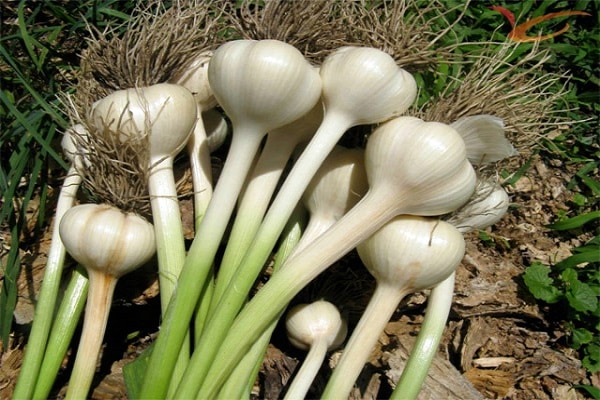
Alcor
Winter garlic is represented by the Alcor variety, which has an average ripening period. Up to 11 leaves develop on the stem, the length of which is 40 cm. The arrow extends up to one meter. Feathers are dark green with a slight bluish tint and pronounced waxy bloom.
The bulb is round in shape and dense in consistency. The color of the husk is pinkish lilac with dark purple longitudinal stripes. The head can have up to 5 large teeth. Each bulb weighs 30 g.
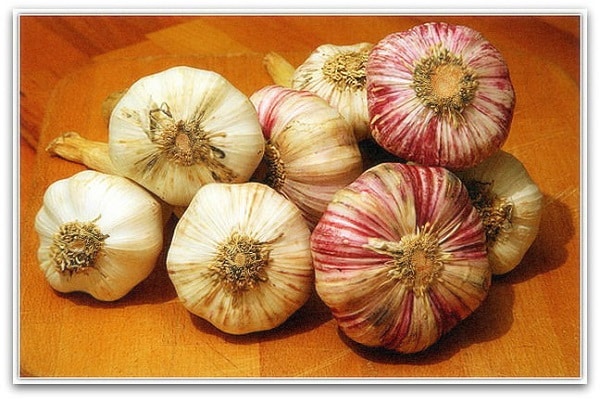
For the successful development of garlic, a lot of space is required, while the variety does not impose special requirements on the composition of the soil. Garlic has a stable yield, frost resistance and high disease resistance.
Planting begins in late September or early October. For planting, it is better to select the outer cloves of the bulb. A well-lit, warm place is chosen on the site. During the entire period of plant development, it is necessary to weed the beds from weeds, cut off the arrows, water once a week and apply fertilizers on time.
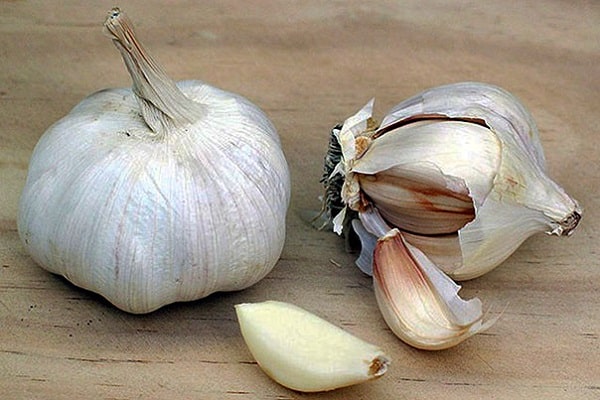
Garqua
The Garkua variety is referred to winter garlic. The plant is characterized by mid-early ripening, vegetable growers start harvesting in mid-June. The rind of the head is white-pink in color.
The main advantages of the variety are high productivity, regardless of the composition of the soil, winter hardiness. Planted garlic cloves do not freeze even at -20 degrees. The denticles are formed small, and their number reaches 16 pieces.

They begin to plant a vegetable at the end of September in the lightest area in the garden. Ideal for clayey or sandy, loosened soils. The largest teeth are chosen as planting material, without damage or stains.After the emergence of seedlings, it is necessary to conduct constant weed control, to loosen the soil after each watering.
Harpek
Garpek variety is distinguished by a high yield. It belongs to vegetables with medium ripening limits; you can start harvesting a ripe crop in mid-July. The head weighing about 70 g includes 10–12 dense, juicy small teeth. The color of the bulb is white and purple.
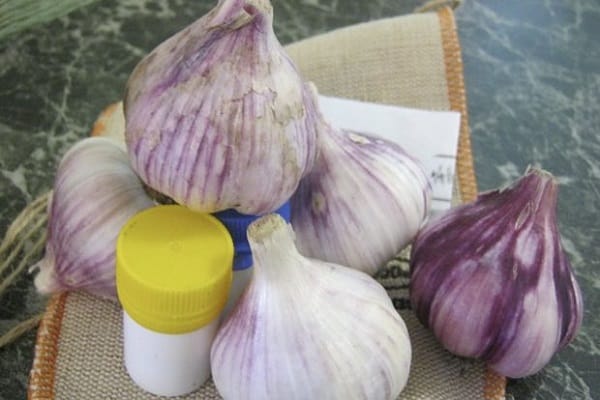
The name of the variety is not so well known among vegetable growers, so in order to make the right choice you need to get acquainted with the characteristics. The variety firmly tolerates winter cold and sudden changes in temperature, requires additional measures to strengthen immunity.
They begin to plant garlic seeds in mid-September in the soil, which was previously dug up and fertilized. Throughout the growing season, the beds need to be loosened and weeded. In order for all nutrients to rush into the underground part of the plant, it is recommended to cut off the arrows with special scissors.
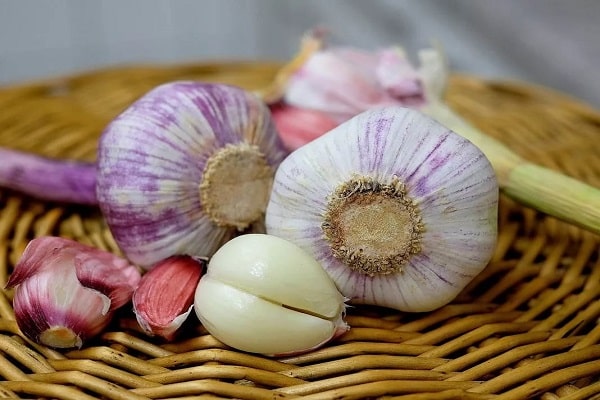
Hermann
Another variety of winter garlic is the Herman variety. Garlic belongs to the mid-season species, the entire growing season lasts 95 days. The leaves are bright green with an unusual waxy bloom, of medium intensity, growing up to 60 cm.
In the rounded-flat head, 6 teeth are formed, which have a complex structure. On average, the heads of garlic weigh 50 g, the scales are painted in a white-lilac color. Differs in long shelf life (up to 8 months), provided that the crop was harvested correctly.
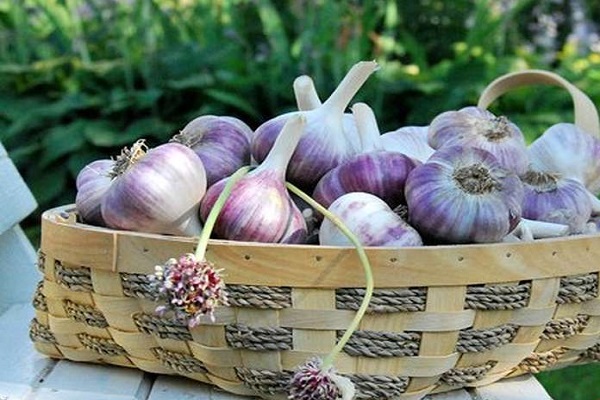
To obtain a large and numerous harvest, it is advised to grow the German variety in a greenhouse in compliance with all the rules. The irrigation regime should be moderate, waterlogging of the soil should not be allowed (drip irrigation is best suited). During the period of leaf germination, the recommended temperature is +20 degrees, and during the period of active growth, a little higher - +23 degrees. To get more nutrients on the bulb, it is recommended to trim the arrows. It is imperative to weed the beds, avoiding weeds and applying fertilizers at certain times.
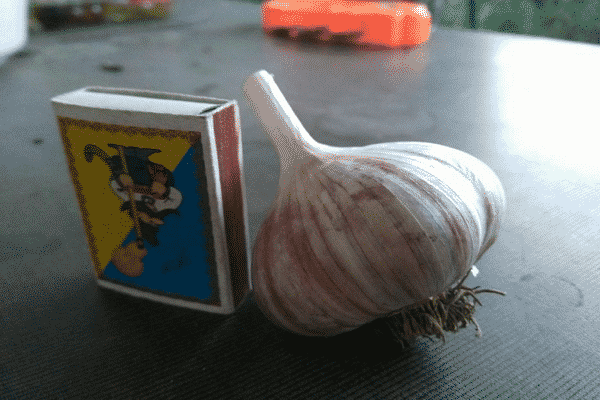
Gribovsky jubilee
The high-yielding variety Gribovsky belongs to the shooters and is valuable for excellent winter hardiness. Mid-late maturity of the head allows you to harvest after 106 days. The length of matte green leaves on the stem reaches 30 cm.
The weight of the slightly flattened head is 35 g; 8–10 teeth are collected inside. Scales of a light purple hue with dark purple stripes. The variety tolerates frost, drought, sudden temperature fluctuations well, and is resistant to fungal and bacterial diseases and greenhouse pests. Does not lend itself to attack by nematodes and onion flies. Diseases such as fusarium, viral mosaic often bypass the plant.

For planting, places are suitable that are far from the shade of trees, a fence or buildings. It develops poorly in heavy soils, a loamy or sandy loam composition is preferable.
Moskal
The giant garlic is popular among gardeners. All varieties are distinguished by large head sizes, the weight of which can be up to 500 g. Most of them tolerate winter well, are disease resistant and give the best results. Common types include: Gulliver, Titan, Alekseevsky, Moskal, Yellow giant, Bashkir-85.
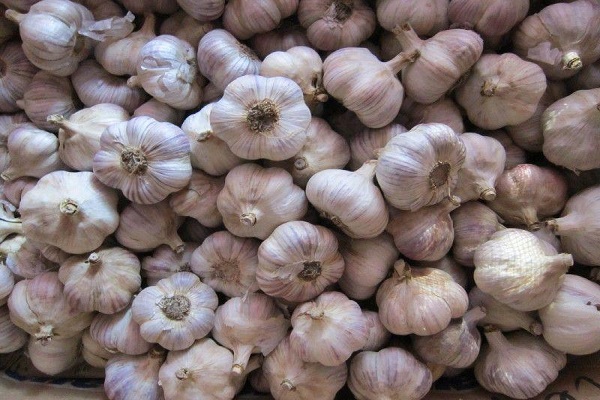
Moskal varietal garlic is distinguished by its gigantic size and the fact that arrows do not form. The rounded-elongated head weighs 80 g. The scales have a lilac-purple color. At the end of the growing season, up to 4 cloves are formed, each of which weighs 20 g.
Komsomolets
The best variety of winter garlic - Komsomolets, tolerates frosts well and forms a large crop, which begins to ripen at the same time. The growing season lasts 115 days, so garlic is classified as a mid-season plant.The length of numerous arrowed leaves reaches 40 cm, arrows can grow more than a meter in length. The color is green with a slight waxy coating.
Dense bulbs weigh 35 g. In good soil, with sufficient fertilization, the weight can reach 105 g. The color of the husk is light purple. Each head contains 10 teeth.
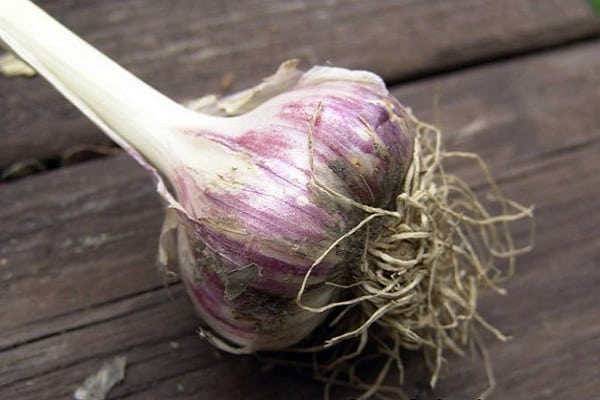
The variety is distinguished by high frost resistance, unpretentious in the care and composition of the soil, resistant to many pathogens, especially to bacterial rot. The harvest is abundant and of good quality.
So that the growth of the plant does not slow down, and the yield remains high, it is necessary to plant it away from the shade, in a well-lit place. The variety does not like moist soil. Planting begins in early October. Before planting, it is recommended to fertilize the soil with compost or humus. After planting, it is advisable to insulate the bed with a layer of mulch (sawdust is suitable).

Lyubasha
The giant garlic variety Lyubasha reaches a height of 120 cm and belongs to plants with early ripening. Leaves grow densely, dark green with a medium waxy bloom, about 40 cm long and 2 cm wide.
With good care, the flat-round head grows large, weighing up to 300 g. The average weight is 110 g. Each bulb has 7 cloves, which are covered with whitish-pink scales with purple veins.
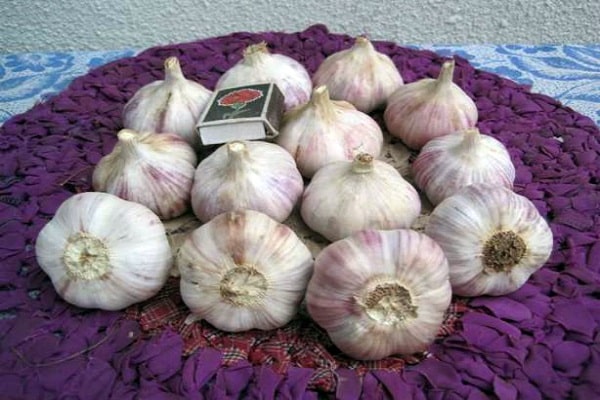
Garlic perfectly tolerates frosts, gives good yields even in dry years, does not impose special requirements on the composition of the soil. Differs in high productivity. It is stored for a long time without losing its useful qualities up to 10 months. It is rarely attacked by pests and almost does not get sick with fungal and bacterial infections.
Planting cloves or seeds is carried out before the first frost appears, until the beginning of November. It is better to plant on a hill, where it is dry and where sunlight enters without obstacles. Previously, the site is dug up, fertilized and the beds are made. Care consists in timely watering and removal of weeds.
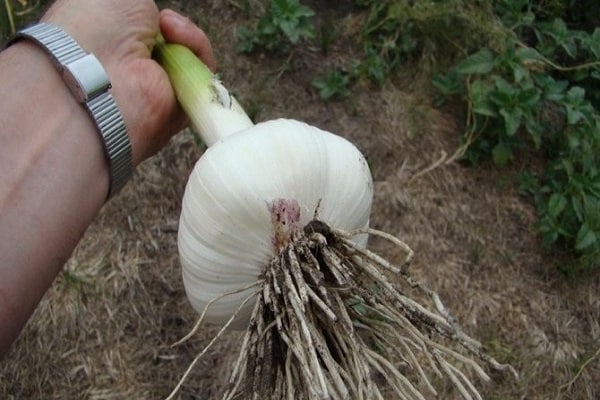
Zubrenok
Winter arrowhead garlic Zubrenok belongs to the mid-early varieties (the growing season lasts about 95 days). The head begins to ripen from the moment the first spring shoots appear after 105 days. The length of dark green feathers with a light waxy bloom reaches 45 cm.
Rounded heads of garlic weighing up to 70 g are formed large, dense with white-cream scales. Up to 7 teeth can form inside. It is better to choose a warm, well-lit place for planting.
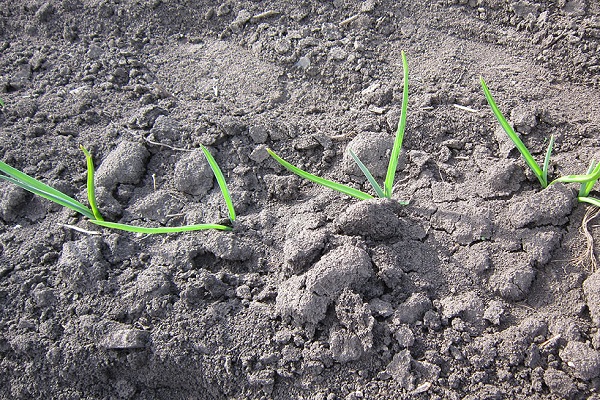
The positive qualities of the variety are high yield, winter hardiness, good keeping quality (the harvest can be stored for up to 7 months), and resistance to fungal diseases.
Garlic is sown in early October. After that, it is recommended to carry out mulching in order to keep warm and additionally provide the soil with trace elements. Sawdust, compost, and straw are chosen as mulch.

Messidor
Before making a choice in favor of the Messidor variety, you need to get acquainted with the description of this type of garlic. It is a very productive, early ripening variety obtained in Holland. The leaves have a deep dark green color, their length reaches 70 cm.The plant does not form an arrow with bulbs.
A round white onion weighing about 115 g contains up to 14 prongs. The plant rarely gets sick, the harvested crop can be stored for a long time. Planting begins in late September or early October, and harvesting begins in late June. The maturity of the heads is judged by the state of the feathers, the neck of the bulb and the scales on it.
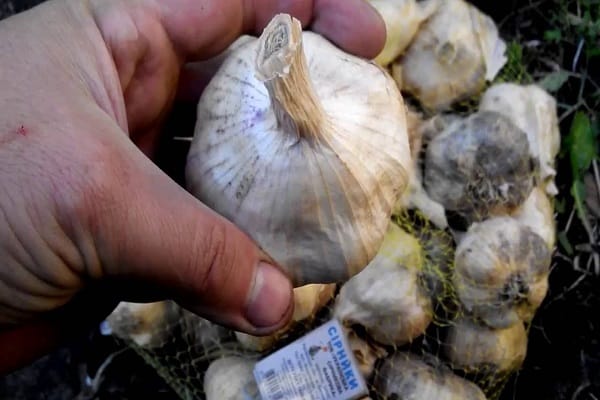
Garlic is resistant to many fungal, viral and bacterial diseases, it tolerates winter with severe frosts. It is possible to collect a rich harvest, which is stored for a long time.
Large, undamaged seeds are selected for planting. In the case when more than three cloves are not formed in the head, the seeds are not selected, since the culture is reborn.Top dressing is carried out three times for the entire season, weeds should not be allowed, watering is moderate.
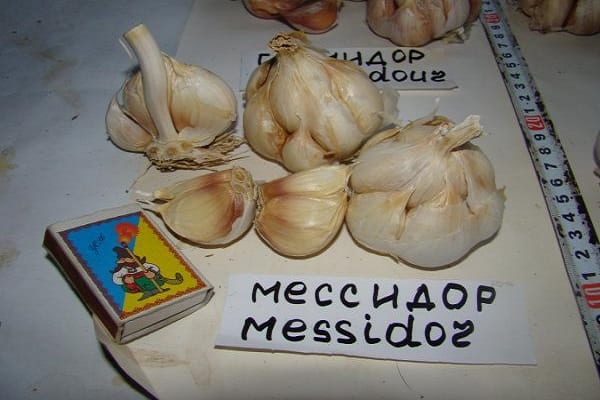
Petrovsky
Petrovsky, a winter variety of garlic that throws out arrows, has an average root crop maturation (mass yellowing of leaves from the moment of their appearance begins after 100 days). The flattened head of a white-purple color weighs about 80 g. Inside, up to 6-8 light brown teeth are formed. The dark green leaves are covered with a waxy coating.
The variety is characterized by the formation of a rich harvest, good keeping quality and resistant to diseases. Garlic thrives in fertile soil with neutral acidity. For planting, choose a sunny, dry place in the garden. It is recommended to plant three weeks before the onset of cold weather (in the last days of September and until mid-October).
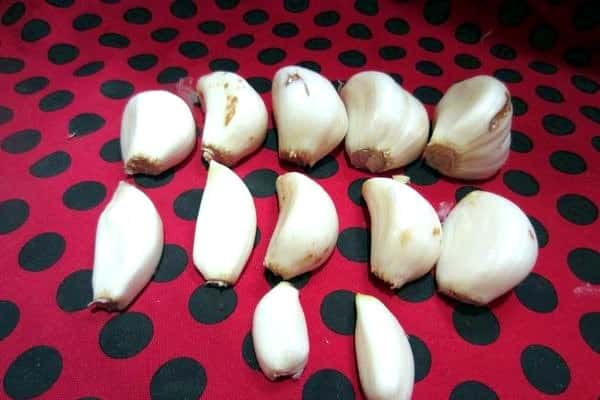
After the first shoots appear, the beds begin to weed, loosen. Fertilizers are applied three times during the entire growing season. The first time fertilization is applied when three leaves appear. The last feeding is carried out three weeks before harvest.
Dubkovsky
Garlic Dubkovsky belongs to winter shooting plants. By the middle of the growing season, arrows with seeds are formed. The variety belongs to the mid-season species, from the moment the first spring shoots appear until the ripening of the bulbs, it takes about 105 days. It is appreciated for its ability to propagate by air bulbs, which have a pale purple hue.
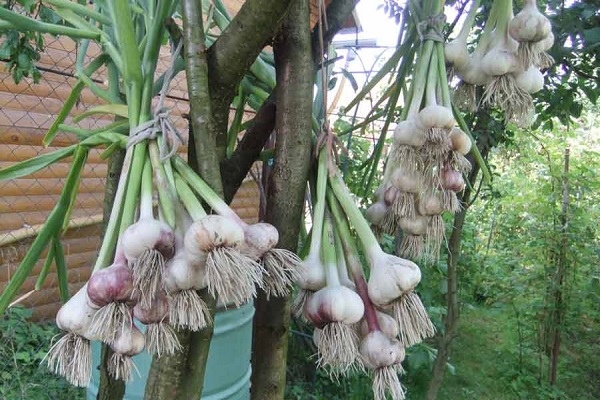
The leaves are bright, saturated green with a weak waxy bloom, their height is about 35 cm. The heads are formed round, slightly flattened, weighing about 35 g. The scales are white-violet. Up to 12 dense lobules are formed inside, their structure is simple.
Subject to the rules of agricultural technology and proper care, high yields are obtained, up to 7 kg from each hundred square meters. The advantages of the variety include frost resistance, long-term keeping quality and resistance to fungal diseases.
It has been noticed that garlic is often affected by a nematode, therefore, preventive treatments of vegetable beds are carried out in time.
Polesie souvenir
Good characteristics are possessed by the arrow-type winter garlic bred by the Belarusian selection - Polessky souvenir. Refers to mid-season varieties, the growing season lasts 100 days.
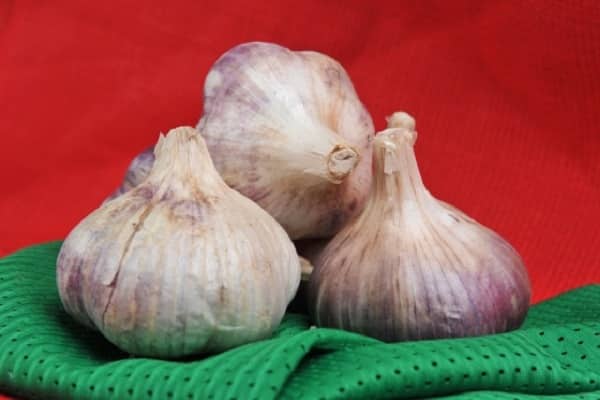
On one stem, up to 10 dark green leaves with a waxy bloom of medium intensity, 58 cm long, unfold. The weight of one rounded bulb with an average density and pinkish scales reaches 150 g. Inside, up to 7 large denticles are formed.
The variety tolerates frosty winters well, it is stored for a long time (up to 8 months) and quickly adapts to various conditions, is resistant to many infections and pests. It is characterized by almost 100% germination rate.
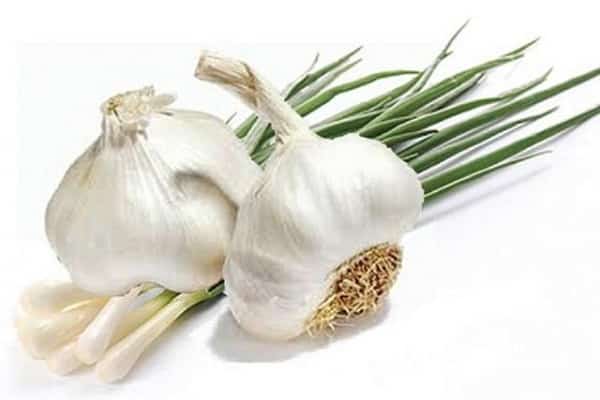
Planting material begins from mid-August to early September. Can be grown both in a greenhouse and outdoors. Garlic requires frequent weeding, at least three drip irrigations per season, responds well to potash fertilization and superphosphate fertilization. During the mass education of the arrows, they are cut off. It is not recommended to plant garlic for more than three years in the same place.
Spas
Garlic Spas is distinguished by positive characteristics: it firmly endures winter with frosts, is resistant to common pathogens, and is not susceptible to nematodes. A rich harvest always ripens, which is stored for a long time. Refers to plants with an average maturation of the heads. It takes about 110 days from the moment the shoots emerge to the complete lodging of the tops.

On the stem, there are about 11 leaves of a dark green color with a light waxy bloom, up to 35 cm long. In the middle of the growing season, many arrows with seeds are formed.
The bulbs have a rounded-oval shape weighing 90 g. The structure of the cloves is simple, their number reaches 8 pieces in one head. The color of the scales is gray-red with purple longitudinal veins.
It can only be grown outdoors in a well-lit and dry place. Caring for vegetable beds consists of timely fertilization, frequent weeding from weeds, loosening and moderate watering.




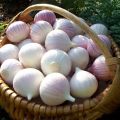
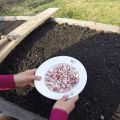


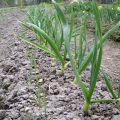

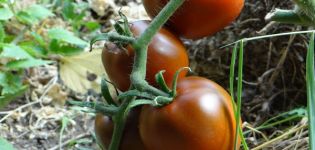
Thanks for the review, I can figure it out with my varieties, but I haven't found my 4-clove one. What kind of variety it is. You need to search the Internet.